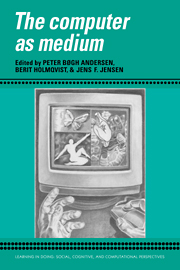Book contents
- Frontmatter
- Contents
- Series foreword
- Preface
- Contributors
- Part I Computer-based signs
- Part II The rhetoric of interactive media
- Part III Computers in context
- Introduction
- 13 Computer culture: The meaning of technology and the technology of meaning
- 14 One person, one computer: The social construction of the personal computer
- 15 Hi-tech network organizations as self-referential systems
- Comment: Disturbing communication
- 16 Dialogues in networks
- 17 Historical trends in computer and information technology
- Comment: The history of computer-based signs
- 18 A historical perspective on work practices and technology
- 19 Hypertext: From modem Utopia to post-modem dystopia?
- Index
17 - Historical trends in computer and information technology
Published online by Cambridge University Press: 05 October 2010
- Frontmatter
- Contents
- Series foreword
- Preface
- Contributors
- Part I Computer-based signs
- Part II The rhetoric of interactive media
- Part III Computers in context
- Introduction
- 13 Computer culture: The meaning of technology and the technology of meaning
- 14 One person, one computer: The social construction of the personal computer
- 15 Hi-tech network organizations as self-referential systems
- Comment: Disturbing communication
- 16 Dialogues in networks
- 17 Historical trends in computer and information technology
- Comment: The history of computer-based signs
- 18 A historical perspective on work practices and technology
- 19 Hypertext: From modem Utopia to post-modem dystopia?
- Index
Summary
It has been truly said that the computer is the most economically important technological innovation of this century. No other piece of technology has expanded in a way comparable to that of the computer. A vast computer industry has emerged, and what is perhaps even more important, since the 1980s applied computer technology has spread so widely throughout the worlds of business, public administration, science, and so on. that an economy of information seems to be substituting the industrial economy. “Information” also indicates the tremendous changes that have taken place in computing technology and applied technology since computing started in the 1940s. What began as the history of computing is now being transformed into the history of information technology and information society. It is no wonder that the historian and the social and economic analyst of modern technology are experiencing difficulties in coping with this huge and expanding field of research.
Until the 1980s, the American computer industry dominated the international development of the computer, and IBM surpassed any other company to such a degree that everybody else was reduced to followers of the leader. The 1980s saw changes in this pattern, however. European and particularly Japanese industry rose to equal the Americans in many fields of technology, while industry and applications were being radically changed all over the place. This trend has continued into the 1990s.
- Type
- Chapter
- Information
- The Computer as Medium , pp. 422 - 451Publisher: Cambridge University PressPrint publication year: 1994



